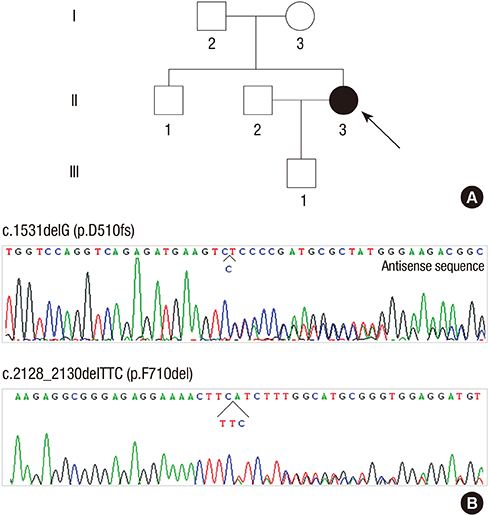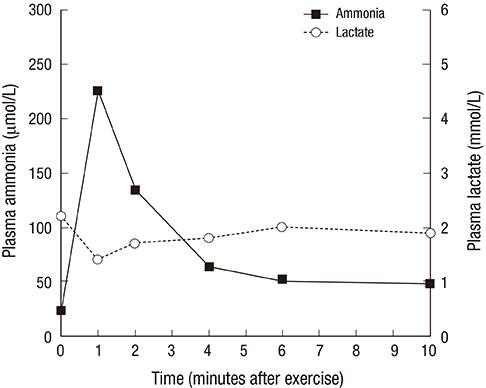J Korean Med Sci.
2014 Jul;29(7):1021-1024. 10.3346/jkms.2014.29.7.1021.
The Significance of Clinical and Laboratory Features in the Diagnosis of Glycogen Storage Disease Type V: A Case Report
- Affiliations
-
- 1Department of Neurology, Mokdong Hospital, Ewha Womans University School of Medicine, Seoul, Korea.
- 2Department of Neurology, Yonsei University College of Medicine, Seoul, Korea. ycchoi@yuhs.ac
- 3Rehabilitation Institute of Neuromuscular Disease, Yonsei University College of Medicine, Seoul, Korea.
- KMID: 1789966
- DOI: http://doi.org/10.3346/jkms.2014.29.7.1021
Abstract
- Glycogen storage disease type V (GSD-V) is the most common disorder of muscle glycogenosis with characteristic clinical and laboratory findings. A 32-yr-old woman complained of exercise intolerance and myoglobulinuria since early adolescence. She reported several episodes of second-wind phenomenon. Physical examination did not show any neurological abnormality, including fixed muscle weakness or atrophy. Serum creatine kinase level was 1,161 IU/L at rest. The result of the non-ischemic forearm exercise test was compatible with GSD-V. Mutation analysis identified the compound heterozygous mutations of the PYGM, p.D510fs and p.F710del, which has not yet been reported in Korea. The present case recognizes that detail clinical and laboratory analysis is the first step in the diagnosis of GSD-V.
MeSH Terms
Figure
Cited by 1 articles
-
Recurrent Episodes of Rhabdomyolysis after Seizures in a Patient with Glycogen Storage Disease Type V
Hyung Jun Park, Yoonkyung Chang, Jee Eun Lee, Heasoo Koo, Jeeyoung Oh, Young-Chul Choi, Kee Duk Park
J Clin Neurol. 2016;12(3):373-375. doi: 10.3988/jcn.2016.12.3.373.
Reference
-
1. Vieitez I, Teijeira S, Fernandez JM, San Millan B, Miranda S, Ortolano S, Louis S, Laforet P, Navarro C. Molecular and clinical study of McArdle's disease in a cohort of 123 European patients: identification of 20 novel mutations. Neuromuscul Disord. 2011; 21:817–823.2. Dimaur S, Andreu AL, Bruno C, Hadjigeorgiou GM. Myophosphorylase deficiency (glycogenosis type V; McArdle disease). Curr Mol Med. 2002; 2:189–196.3. Haller RG. Treatment of McArdle disease. Arch Neurol. 2000; 57:923–924.4. Lucia A, Ruiz JR, Santalla A, Nogales-Gadea G, Rubio JC, García-Consuegra I, Cabello A, Pérez M, Teijeira S, Vieitez I, et al. Genotypic and phenotypic features of McArdle disease: insights from the Spanish national registry. J Neurol Neurosurg Psychiatry. 2012; 83:322–328.5. Sohn EH, Kim HS, Lee AY, Fukuda T, Sugie H, Kim DS. A novel PYGM mutation in a Korean patient with McArdle disease: the role of nonsense-mediated mRNA decay. Neuromuscul Disord. 2008; 18:886–889.6. Tsujino S, Shanske S, Goto Y, Nonaka I, DiMauro S. Two mutations, one novel and one frequently observed, in Japanese patients with McArdle's disease. Hum Mol Genet. 1994; 3:1005–1006.7. Haller RG, Clausen T, Vissing J. Reduced levels of skeletal muscle Na+K+-ATPase in McArdle disease. Neurology. 1998; 50:37–40.8. Clausen T, Nielsen OB. The Na+,K(+)-pump and muscle contractility. Acta Physiol Scand. 1994; 152:365–373.9. Kazemi-Esfarjani P, Skomorowska E, Jensen TD, Haller RG, Vissing J. A nonischemic forearm exercise test for McArdle disease. Ann Neurol. 2002; 52:153–159.10. Dyken ML, Smith DM, Peake RL. An electromyographic diagnostic screening test in McArdle's disease and a case report. Neurology. 1967; 17:45–50.11. Lorenzoni PJ, Lange MC, Kay CS, Scola RH, Werneck LC. Motor nerve conduction study in McArdle disease: case report. Arq Neuropsiquiatr. 2005; 63:874–877.12. Clarkson PM, Hubal MJ. Exercise-induced muscle damage in humans. Am J Phys Med Rehabil. 2002; 81:S52–S69.13. Lucia A, Nogales-Gadea G, Pérez M, Martín MA, Andreu AL, Arenas J. McArdle disease: what do neurologists need to know? Nat Clin Pract Neurol. 2008; 4:568–577.14. Vissing J, Haller RG. A diagnostic cycle test for McArdle's disease. Ann Neurol. 2003; 54:539–542.15. Haller RG, Vissing J. Spontaneous "second wind" and glucose-induced second "second wind" in McArdle disease: oxidative mechanisms. Arch Neurol. 2002; 59:1395–1402.16. Wolfe GI, Baker NS, Haller RG, Burns DK, Barohn RJ. McArdle's disease presenting with asymmetric, late-onset arm weakness. Muscle Nerve. 2000; 23:641–645.17. Bruno C, Cassandrini D, Martinuzzi A, Toscano A, Moggio M, Morandi L, Servidei S, Mongini T, Angelini C, Musumeci O, et al. McArdle disease: the mutation spectrum of PYGM in a large Italian cohort. Hum Mutat. 2006; 27:718.18. Martín MA, Rubio JC, Buchbinder J, Fernández-Hojas R, del Hoyo P, Teijeira S, Gámez J, Navarro C, Fernández JM, Cabello A, et al. Molecular heterogeneity of myophosphorylase deficiency (McArdle's disease): a genotype-phenotype correlation study. Ann Neurol. 2001; 50:574–581.19. Sugie H, Sugie Y, Ito M, Fukuda T, Nonaka I, Igarashi Y. Genetic analysis of Japanese patients with myophosphorylase deficiency (McArdle's disease): single-codon deletion in exon 17 is the predominant mutation. Clin Chim Acta. 1995; 236:81–86.



